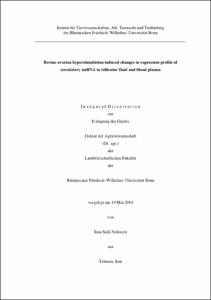Seifi Noferesti, Sina: Bovine ovarian hyperstimulation induced changes in expression profile of circulatory miRNA in follicular fluid and blood plasma. - Bonn, 2014. - Dissertation, Rheinische Friedrich-Wilhelms-Universität Bonn.
Online-Ausgabe in bonndoc: https://nbn-resolving.org/urn:nbn:de:hbz:5n-38273
Online-Ausgabe in bonndoc: https://nbn-resolving.org/urn:nbn:de:hbz:5n-38273
@phdthesis{handle:20.500.11811/5866,
urn: https://nbn-resolving.org/urn:nbn:de:hbz:5n-38273,
author = {{Sina Seifi Noferesti}},
title = {Bovine ovarian hyperstimulation induced changes in expression profile of circulatory miRNA in follicular fluid and blood plasma},
school = {Rheinische Friedrich-Wilhelms-Universität Bonn},
year = 2014,
month = nov,
volume = 171,
note = {Circulatory noncoding small RNAs (miRNAs), which are present in various body fluids, are reported to be potentially used as biomarkers for disease and pregnancy. The present study was conducted to investigate the effect of ovarian hyperstimulation on the expression pattern of circulatory miRNA in follicular fluid and blood plasma. For this, Simmental heifers (n=12) were synchronized using a standard synchronization protocol and six of them were hyperstimulated using FSH. Following this, whole blood samples were collected at day 0 (onset of oestrous), 3 and 7, follicular fluid samples were aspirated from dominant follicles at the day 0 from all animals by ovum pickup. Total RNA including miRNA was isolated from plasma samples of both groups at day 7 and follicular fluid at day 0. Subsequent expression profiling of miRNA was performed using the human miRCURY LNATM Universal RT miRNA PCR array platform with 745 miRNA primer assays. Of the 24 miRNAs, which were differentially expressed in blood plasma between hyperstimulated and unstimulated animals, 9 miRNAs including miR-127-3p, miR-494, miR-147, miR-134 and miR-153 were down regulated and 15 miRNAs including miR-34a, miR-103, let-7g, miR-221 were found to be up regulated in the hyperstimulated animals. Similarly, 66 miRNAs were found to be differentially expressed in follicular fluid derived from hyperstimulated and unstimulated groups. Out of these, while 32 miRNAs were down regulated, 34 were up regulated in follicular fluid aspirated from hyperstimulated animals. Ingenuity pathway analysis (IPA) of potential target genes of candidate miRNAs, which are dysregulated due to ovarian hyperstimulation, revealed axonal guidance signaling and Wnt ß-catenin signaling pathways to be the dominant ones. In conclusion, this study revealed ovarian hyperstimulation resulted in changes in expression profile of circulatory miRNA in blood and follicular fluid.},
url = {https://hdl.handle.net/20.500.11811/5866}
}
urn: https://nbn-resolving.org/urn:nbn:de:hbz:5n-38273,
author = {{Sina Seifi Noferesti}},
title = {Bovine ovarian hyperstimulation induced changes in expression profile of circulatory miRNA in follicular fluid and blood plasma},
school = {Rheinische Friedrich-Wilhelms-Universität Bonn},
year = 2014,
month = nov,
volume = 171,
note = {Circulatory noncoding small RNAs (miRNAs), which are present in various body fluids, are reported to be potentially used as biomarkers for disease and pregnancy. The present study was conducted to investigate the effect of ovarian hyperstimulation on the expression pattern of circulatory miRNA in follicular fluid and blood plasma. For this, Simmental heifers (n=12) were synchronized using a standard synchronization protocol and six of them were hyperstimulated using FSH. Following this, whole blood samples were collected at day 0 (onset of oestrous), 3 and 7, follicular fluid samples were aspirated from dominant follicles at the day 0 from all animals by ovum pickup. Total RNA including miRNA was isolated from plasma samples of both groups at day 7 and follicular fluid at day 0. Subsequent expression profiling of miRNA was performed using the human miRCURY LNATM Universal RT miRNA PCR array platform with 745 miRNA primer assays. Of the 24 miRNAs, which were differentially expressed in blood plasma between hyperstimulated and unstimulated animals, 9 miRNAs including miR-127-3p, miR-494, miR-147, miR-134 and miR-153 were down regulated and 15 miRNAs including miR-34a, miR-103, let-7g, miR-221 were found to be up regulated in the hyperstimulated animals. Similarly, 66 miRNAs were found to be differentially expressed in follicular fluid derived from hyperstimulated and unstimulated groups. Out of these, while 32 miRNAs were down regulated, 34 were up regulated in follicular fluid aspirated from hyperstimulated animals. Ingenuity pathway analysis (IPA) of potential target genes of candidate miRNAs, which are dysregulated due to ovarian hyperstimulation, revealed axonal guidance signaling and Wnt ß-catenin signaling pathways to be the dominant ones. In conclusion, this study revealed ovarian hyperstimulation resulted in changes in expression profile of circulatory miRNA in blood and follicular fluid.},
url = {https://hdl.handle.net/20.500.11811/5866}
}






